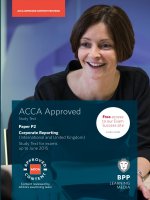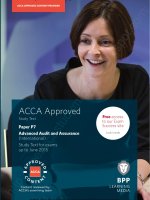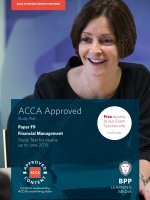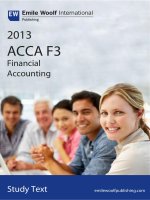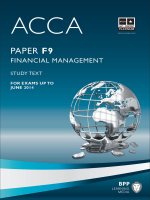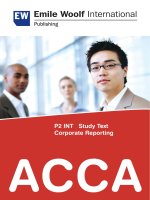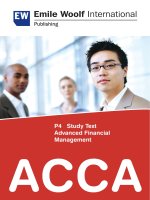ACCA p2 EW INT study text 2010 corporate reporting
Bạn đang xem bản rút gọn của tài liệu. Xem và tải ngay bản đầy đủ của tài liệu tại đây (3.51 MB, 665 trang )
Publishing
P2 INT Study Text
Corporate Reporting
ACCA
Publishing
ACCA Distance Learning Courses
Learn quickly and efficiently
Using a blended learning approach, our distance learning package will steer you towards
exam success.
Our aim is to teach you all you need to know and give you plenty of practice, without
bombarding you with excessive detail. We therefore offer you the following tailored package:
•
Access to our dedicated distance learning website – where you’ll find a regular blog from the distance
learning department – reminders, hints and tips, study advice and other ideas from tutors, writers and
markers – as well as access to your course material
•
•
Tutor support – by phone or by email, answered within 48 hours
The handbook – outlining distance learning with us and helping you understand the ACCA course
Study phase
Revision phase
•
The key study text – covering the
syllabus without excessive detail and
containing a bank of practice questions
for plenty of reinforcement of key topics
•
A key study guide – guiding you through
the study text and helping you revise
•
An online question bank for additional
reinforcement of knowledge
•
An exam kit – essential for exam
preparation and packed with examstandard practice questions
•
2 tutor-marked mock exams to be sat
during your studies
•
Key notes - highlighting the key
topics in an easy-to-use format
Total price: £160.95
Visit us at
www.emilewoolfpublishing.com
tel: +44(0) 1483 225746
ACCA
ACCA
Paper
P2
Corporate Reporting
(International)
Welcome to Emile Woolf‘s study text for
Paper P2 Corporate Reporting (INT) which is:
Written by tutors
Comprehensive but concise
In simple English
Used around the world by Emile Woolf Colleges including
China, Russia and the UK
Publishing
Four edition published by
Emile Woolf Publishing Limited
Crowthorne Enterprise Centre, Crowthorne Business Estate, Old Wokingham Road,
Crowthorne, Berkshire RG45 6AW
Email:
www.emilewoolfpublishing.com
© Emile Woolf Publishing Limited, September 2010
All rights reserved. No part of this publication may be reproduced, stored in a retrieval
system, or transmitted, in any form or by any means, electronic, mechanical, photocopying,
recording, scanning or otherwise, without the prior permission in writing of Emile Woolf
Publishing Limited, or as expressly permitted by law, or under the terms agreed with the
appropriate reprographics rights organisation.
You must not circulate this book in any other binding or cover and you must impose
the same condition on any acquirer.
Notice
Emile Woolf Publishing Limited has made every effort to ensure that at the time of
writing the contents of this study text are accurate, but neither Emile Woolf Publishing
Limited nor its directors or employees shall be under any liability whatsoever for any
inaccurate or misleading information this work could contain.
British Library Cataloguing in Publications Data
A catalogue record for this book is available from the British Library.
ISBN: 978‐1‐84843‐111‐9
Printed and bound in Great Britain
Acknowledgements
The Syllabus and study guide are reproduced by kind permission of the Association of
Chartered Certified Accountants.
All IASB material is adapted and reproduced with the kind permission of the International
Accounting Standards Committee Foundation. © International Accounting Standards
Committee Foundation (IASB). All rights reserved.
ii
Go to www.emilewoolfpublishing.com for Q/As, Notes & Study Guides
© EWP
Paper P2 (INT)
Corporate Reporting
c
Contents
Page
Syllabus and study guide
1
Chapter 1
The financial reporting framework
11
Chapter 2
The professional and ethical duty of the accountant
53
Chapter 3
Social reporting
61
Chapter 4
Group financial statements
71
Chapter 5
Group financial statements: complex groups
131
Chapter 6
Group financial statements: step acquisitions and disposals
155
Chapter 7
Group reorganisations and restructuring
171
Chapter 8
Foreign currency
185
Chapter 9
Statements of cash flows
211
Chapter 10
Non-current assets
245
Chapter 11
Financial instruments
277
Chapter 12
Leases and substance over form
315
Chapter 13
Reporting requirements for listed companies
337
Chapter 14
Employee benefits and share based payments
361
Chapter 15
Taxation
391
Chapter 16
Reporting financial performance
413
Chapter 17
Provisions and events after the reporting period
441
Chapter 18
Other accounting standards
469
Chapter 19
Specialised entities
485
© EWP Go to www.emilewoolfpublishing.com for Q/As, Notes & Study Guides
iii
Paper P2: Corporate Reporting (International)
iv
Chapter 20
Performance measurement
495
Chapter 21
Other issues
523
Practice questions
531
Answers
575
Index
649
Go to www.emilewoolfpublishing.com for Q/As, Notes & Study Guides
© EWP
Examinable documents
Examinable documents
International Accounting Standards (IASs)/International Financial
Reporting Standards (IFRSs)
Chapter:
IAS 1
IAS 2
IAS 7
IAS 8
IAS 10
IAS 11
IAS 12
IAS 16
IAS 17
IAS 18
IAS 19
IAS 20
IAS 21
IAS 23
IAS 24
IAS 27
IAS 28
IAS 29
IAS 31
IAS 32
IAS 33
IAS 34
IAS 36
IAS 37
IAS 38
IAS 39
IAS 40
IAS 41
IFRS 1
IFRS 2
IFRS 3
IFRS 5
IFRS 7
IFRS 8
Presentation of Financial Statements
Inventories
Statements of Cash Flows
Accounting Policies, Changes in Accounting Estimates and Errors
Events after the Reporting Period
Construction Contracts
Income Taxes
Property, Plant and Equipment
Leases
Revenue
Employee Benefits
Accounting for Government Grants and Disclosure of Government
Assistance
The Effects of Changes in Foreign Exchange Rates
Borrowing Costs
Related Party Disclosures
Consolidated and Separate Financial Statements
Investments in Associates
Financial Reporting in Hyperinflationary Economies
Interests in Joint Ventures
Financial Instruments: Disclosure and Presentation
Earnings per Share
Interim Financial Reporting
Impairment of Assets
Provisions, Contingent Liabilities and Contingent Assets
Intangible Assets
Financial Instruments: Recognition and Measurement
Investment Property
Agriculture
First-time Adoption of International Financial Reporting Standards
Share-based Payment
Business Combinations
Non-Current Assets Held for Sale and Discontinued Operations
Financial Instruments: Disclosures
Segment Reporting
1
18
9
1
17
18
15
10
12
16
14
10
8
10
16
4, 6
4
8
4
11
13
13
10
17
10
11
10
18
21
14
4, 6
10, 16
11
13
Other Statements
Framework for the Preparation and Presentation of Financial Statements
© EWP Go to www.emilewoolfpublishing.com for Q/As, Notes & Study Guides
1
iii
Paper P2: Corporate Reporting (International)
Interpretations of the International Financial Reporting
Interpretations Committee (IFRIC)
SIC-12
SIC-13
SIC-15
SIC-21
SIC-27
SIC-32
IFRIC 1
IFRIC 4
IFRIC 5
IFRIC 7
IFRIC 8
IFRIC 9
IFRIC 10
IFRIC 11
IFRIC 12
IFRIC 13
IFRIC 16:
Consolidation – Special Purpose Entities
Jointly Controlled Entities – Non monetary Contributions by
Venturers
Operating Leases – Incentives
Income Taxes – Recovery of Revalued Non-Depreciable Assets
Evaluating the Substance of Transactions in the Legal Form of a
Lease
Intangible Assets – Website Costs
Changes in Existing Decommissioning, Restoration and Similar
Liabilities
Determining Whether an Arrangement Contains a Lease
Rights to Interests from Decommissioning Restoration and
Funds
Applying the Restatement Approach under IAS 29, Financial
Reporting in Hyperinflationary Economies
Scope of IFRS 2
Reassessment of Embedded Derivatives
Interim Financial Reporting and Impairment
IFRS2: Group and Treasury Share Transactions
Service Concession Arrangements
Customer Loyalty Programmes
Hedges of a Net Investment in a Foreign Operation
12
4
12
15
12
10
17
12
17
8
14
11
13
14
17
11
EDs, Discussion Papers and Other Documents
ED IFRS for Small and Medium-Sized Entities
ED Preliminary Views on an Improved Conceptual Framework for Financial
Reporting – The Objective of Financial Reporting and Qualitative
Characteristics of Decision-Useful Financial Reporting Information
ED Simplifying Earnings per Share: Proposed Amendments to IAS33
ED Improvements to IFRSs
13
21
DP
DP
DP
DP
1
1
11
14
iv
Management Commentary
Fair Value Measurements
Reducing Complexity in Reporting Financial Instruments
Preliminary Views on Amendments to IAS 19, Employee Benefits
Go to www.emilewoolfpublishing.com for Q/As, Notes & Study Guides
19
1
© EWP
Paper P2 (INT)
Corporate Reporting
S
Syllabus and study guide
Aim
To apply knowledge, skills and exercise professional judgement in the application
and evaluation of financial reporting principles and practices in a range of business
contexts and situations.
Main capabilities
On successful completion of this paper, candidates should be able to:
A
Discuss the professional and ethical duties of the accountant
B
Evaluate the financial reporting framework
C
Advise on and report the financial performance of entities
D
Prepare the financial statements of groups of entities in accordance with
relevant accounting standards
E
Explain reporting issues relating to specialised entities
F
Discuss the implications of changes in accounting regulation on financial
reporting
G
Appraise the financial performance and position of entities
H
Evaluate current developments
© EWP Go to www.emilewoolfpublishing.com for Q/As, Notes & Study Guides
1
Paper P2: Corporate Reporting (International)
Syllabus content
A
B
C
D
E
F
2
The professional and ethical duty of the accountant
1.
Professional behaviour and compliance with accounting standards
2.
Ethical requirements of corporate reporting and the consequences of
unethical behaviour
3.
Social responsibility
The financial reporting framework
1.
The contribution and limitations of financial statements in meeting the
needs of users and capital markets
2.
The applications, strengths and weaknesses of an accounting framework
3.
Critical evaluation of principles and practices
Reporting the financial performance of entities
1.
Performance reporting
2.
Non-current assets
3.
Financial instruments
4.
Leases
5.
Segment reporting
6.
Employee benefits
7.
Income taxes
8.
Provisions, contingencies and events after the reporting date
9.
Related parties
10.
Share-based payment
Financial statements of groups of entities
1.
Group accounting including statements of cash flows
2.
Continuing and discontinued interests
3.
Changes in group structures
4.
Foreign transactions and entities
Specialised entities
1.
Financial reporting in specialised, not-for-profit and public sector
entities
2.
Reporting requirements of small and medium- sized entities (SMEs)
Implications of changes in accounting regulation on financial reporting
1.
The effect of changes in accounting standards on accounting systems
2.
Proposed changes to accounting standards
Go to www.emilewoolfpublishing.com for Q/As, Notes & Study Guides
© EWP
Syllabus and study guide
G
H
The appraisal of financial performance and position of entities
1.
The creation of suitable accounting policies
2.
Analysis and interpretation of financial information and measurement
of performance
Current developments
1.
Environmental and social reporting
2.
Convergence between national and international reporting standards
3.
Comparison of national reporting requirements
4.
Current reporting issues
Approach to examining the syllabus
The syllabus is assessed by a three-hour paper-based examination. It examines
professional competences within the corporate reporting environment.
Students will be examined on concepts, theories, and principles, and on their ability
to question and comment on proposed accounting treatments.
Students should be capable of relating professional issues to relevant concepts and
practical situations. The evaluation of alternative accounting practices and the
identification and prioritisation of issues will be a key element of the paper.
Professional and ethical judgement will need to be exercised, together with the
integration of technical knowledge when addressing corporate reporting issues in a
business context.
Global issues will be addressed via the current issues questions on the paper.
Students will be required to adopt either a stakeholder or an external focus in
answering questions and to demonstrate personal skills such as problem solving,
dealing with information and decision making.
The paper also deals with specific professional knowledge appropriate to the
preparation and presentation of consolidated and other financial statements from
accounting data to conform with accounting standards.
The paper will comprise two sections.
Section A
Compulsory question
50 marks
Section B
2 from 3 questions of 25 marks each
50 marks
–––––––––––––––––––––––––
100 marks
–––––––––––––––––––––––––
Section A will consist of one scenario-based question worth 50 marks. It will deal
with the preparation of consolidated financial statements including group
statements of cash flows and with issues in financial reporting.
Students will be required to answer two out of three questions in Section B, which
will normally comprise two questions which will be scenario or case-study based
and one question which will be an essay. Section B could deal with any aspects of
the syllabus.
© EWP Go to www.emilewoolfpublishing.com for Q/As, Notes & Study Guides
3
Paper P2: Corporate Reporting (International)
Study Guide
This study guide more detailed guidance on the syllabus. You should use this as the
basis of your studies.
A
THE PROFESSIONAL AND ETHICAL DUTIES OF THE ACCOUNTANT
1.
2.
3.
B
a)
Appraise and discuss the ethical and professional issues in
advising on corporate reporting.
b)
Assess the relevance and importance of ethical and professional
issues in complying with accounting standards.
Ethical requirements of corporate reporting and the consequences
of unethical behaviour
a)
Appraise the potential ethical implications of professional and
managerial decisions in the preparation of corporate reports.
b)
Assess the consequences of not upholding ethical principles in the
preparation of corporate reports.
Social Responsibility
a)
Discuss the increased demand for transparency in corporate
reports, and the emergence of non-financial reporting standards.
b)
Discuss the progress towards a framework for environmental and
sustainability reporting.
THE FINANCIAL REPORTING FRAMEWORK
1.
2.
3.
4
Professional behaviour and compliance with accounting standards
The contribution and limitations of financial statements in meeting
users’ and capital markets’ needs
a)
Evaluate the consistency and clarity of corporate reports.
b)
Assess the insight into financial and operational risks provided by
corporate reports.
c)
Discuss the usefulness of corporate reports in making investment
decisions.
The applications, strengths and weaknesses of an accounting
framework
a)
Evaluate the valuation models adopted by standard setters.
b)
Discuss the use of an accounting framework in underpinning the
production of accounting standards.
c)
Assess the success of such a framework in introducing rigorous
and consistent accounting standards.
Critical evaluation of principles and practices
a)
Identify the relationship between accounting theory and practice.
b)
Critically evaluate accounting principles and practices used in
corporate reporting.
Go to www.emilewoolfpublishing.com for Q/As, Notes & Study Guides
© EWP
Syllabus and study guide
C
REPORTING THE FINANCIAL PERFORMANCE OF ENTITIES
1.
2.
3.
4.
5.
Performance reporting
a)
Prepare reports relating to corporate performance for external
stakeholders.
b)
Discuss the issues relating to the recognition of revenue
c)
Evaluate proposed changes to reporting financial performance.
Non-current assets
a)
Apply and discuss the timing of the recognition of non-current
assets and the determination of their carrying amounts including
impairments and revaluations.
b)
Apply and discuss the treatment of non-current assets held for
sale.
c)
Apply and discuss the accounting treatment of investment
properties including classification, recognition and measurement
issues.
d)
Apply and discuss the accounting treatment of intangible assets
including the criteria for recognition and measurement subsequent
to acquisition and classification.
Financial instruments
a)
Apply and discuss the recognition and de-recognition of financial
assets and financial liabilities.
b)
Apply and discuss the classification of financial assets and
financial liabilities and their measurement.
c)
Apply and discuss the treatment of gains and losses arising on
financial assets and financial liabilities.
d)
Apply and discuss the treatment of impairments of financial
assets.
e)
Account for derivative
embedded derivatives.
f)
Outline the principles of hedge accounting and account for fair
value hedges and cash flow hedges including hedge effectiveness.
financial
instruments,
and
simple
Leases
a)
Apply and discuss the classification of leases and accounting for
leases by lessors and lessees.
b)
Account for and discuss sale and leaseback transactions.
Segment reporting
a)
Determine business and geographical segments, and reportable
segments.
b)
Specify and discuss the nature of segment information to be
disclosed.
© EWP Go to www.emilewoolfpublishing.com for Q/As, Notes & Study Guides
5
Paper P2: Corporate Reporting (International)
6.
7.
8.
9.
10.
D
a)
Apply and discuss the accounting
contribution and defined benefit plans.
treatment
of
defined
b)
Account for gains and losses on settlements and curtailments.
c)
Account for the “Asset Ceiling” test and the reporting of actuarial
gains and losses.
Income taxes
a)
Apply and discuss the recognition and measurement of deferred
tax liabilities and deferred tax assets including the exceptions to
recognition.
b)
Determine the recognition of tax expense or income and its
inclusion in the financial statements.
Provisions, contingencies and events after the reporting date
a)
Apply and discuss the recognition, derecognition and
measurement of provisions, contingent liabilities and contingent
assets including environmental provisions.
b)
Calculate and discuss restructuring provisions.
c)
Apply and discuss the accounting for events after the reporting
date.
d)
Determine and report going concern issues arising after the
reporting date.
Related parties
a)
Determine the parties considered to be related to an entity.
b)
Identify the implications of related party relationships and the
need for disclosure.
Share based payment
a)
Apply and discuss the recognition and measurement criteria for
share-based payment transactions.
b)
Account for modifications, cancellations and settlements of share
based payment transactions.
FINANCIAL STATEMENTS OF GROUPS OF ENTITIES
1.
6
Employee benefits
Group accounting including statements of cash flows
a)
Apply the method of accounting for business combinations
including complex group structures.
b)
Apply the principles in determining the cost of a business
combination.
Go to www.emilewoolfpublishing.com for Q/As, Notes & Study Guides
© EWP
Syllabus and study guide
2.
3.
4.
E
c)
Apply the recognition and measurement criteria for identifiable
acquired assets and liabilities and goodwill including step
acquisitions.
d)
Apply and discuss the criteria used to identify a subsidiary and an
associate.
e)
Determine and apply appropriate procedures to be used in
preparing group financial statements.
f)
Apply the equity method of accounting for associates.
g)
Outline and apply the key definitions and accounting methods
which relate to interests in joint ventures.
h)
Prepare and discuss group statements of cash flows.
Continuing and discontinued interests
a)
Prepare group financial statements where activities have been
discontinued, or have been acquired or disposed of in the period.
b)
Apply and discuss the treatment of a subsidiary which has been
acquired exclusively with a view to subsequent disposal.
Changes in group structures
a)
Discuss the reasons behind a group reorganisation.
b)
Evaluate and assess the principal terms of a proposed group
reorganisation.
Foreign transactions and entities
a)
Outline and apply the translation of foreign currency amounts and
transactions into the functional currency and the presentational
currency.
b)
Account for the consolidation of foreign operations and their
disposal.
c)
Describe the principal objectives of establishing a standard for
enterprises reporting in the currency of a hyper inflationary
economy.
SPECIALISED ENTITIES
1.
Financial reporting in specialised, not-for-profit and public sector
entities
a)
2.
Apply knowledge from the syllabus to straightforward
transactions and events arising in specialised, not-for-profit, and
public sector entities.
Reporting requirements of small and medium entities (SMEs)
a)
Outline the principal considerations in developing a set of
accounting standards for SMEs.
b)
Discuss solutions to the problem of differential financial reporting.
© EWP Go to www.emilewoolfpublishing.com for Q/As, Notes & Study Guides
7
Paper P2: Corporate Reporting (International)
F
IMPLICATIONS OF CHANGES IN ACCOUNTING REGULATION ON
FINANCIAL REPORTING
1.
2.
G
2.
Apply and discuss the accounting implications of the first time
adoption of a body of new accounting standards.
b)
Outline the issues in implementing a change to new accounting
standards including organisational, behavioural, and procedural
changes within the entity.
Proposed changes to accounting standards
a)
Identify issues and deficiencies which have led to a proposed
change to an accounting standard.
b)
Apply and discuss the implications of a proposed change to an
accounting standard on the performance and statement of
financial position of an entity.
The creation of suitable accounting policies
a)
Develop accounting policies for an entity which meet the entity’s
reporting requirements.
b)
Identify accounting treatments adopted in financial statements
and assess their suitability and acceptability.
Analysis and interpretation
measurement of performance
of
financial
information
and
a)
Select and calculate relevant indicators of financial and nonfinancial performance.
b)
Identify and evaluate significant features and issues in financial
statements.
c)
Highlight inconsistencies in financial information through analysis
and application of knowledge.
d)
Make inferences from the analysis of information taking into
account the limitation of the information, the analytical methods
used and the business environment in which the entity operates.
CURRENT DEVELOPMENTS
1.
8
a)
THE APPRAISAL OF FINANCIAL PERFORMANCE AND POSITION OF
ENTITIES
1.
H
The effect of changes in accounting standards on accounting
systems
Environmental and social reporting
a)
Appraise the impact of environmental, social, and ethical factors
on performance measurement.
b)
Evaluate current reporting requirements in the area.
c)
Discuss why entities might include disclosures relating to the
environment and society.
Go to www.emilewoolfpublishing.com for Q/As, Notes & Study Guides
© EWP
Syllabus and study guide
2.
3.
4.
Convergence
standards
between
national
and
international
reporting
a)
Evaluate the implications, nationally and globally, of convergence
with International Financial Reporting Standards.
b)
Discuss the implementation issues arising from the convergence
process.
Comparison of national reporting requirements
a)
Identify the reasons for major differences in accounting practices,
including culture.
b)
Discuss the influence of national regulators on international
financial reporting.
Current reporting issues
a)
Discuss current issues in corporate reporting.
© EWP Go to www.emilewoolfpublishing.com for Q/As, Notes & Study Guides
9
Paper P2: Corporate Reporting (International)
10
Go to www.emilewoolfpublishing.com for Q/As, Notes & Study Guides
© EWP
CHAPTER
Paper P2 (INT)
Corporate Reporting
1
The financial reporting
framework
Contents
1
The regulatory framework
2
Constitution and objectives of the IASC
Foundation and the IASB
3
A conceptual framework for financial reporting
4
The IASB Framework
5
Qualitative characteristics of financial statements
6
The elements of financial statements
7
Recognition in the financial statements
8
Accounting policies
9
Accounting concepts
10
Fair presentation
11
IFRSs and measurement
12
Recent developments
© EWP Go to www.emilewoolfpublishing.com for Q/As, Notes & Study Guides
11
Paper P2: Corporate Reporting (International)
The regulatory framework
Introduction
The need for regulation
Sources of regulation
Principles and rules
1
The regulatory framework
1.1
Introduction
Much of the content of this chapter will already be familiar to you. The regulatory
framework has already been examined in your previous studies. This subject is still
examinable, but the focus is slightly different. The Examiner expects higher level
skills, expecting you to be able to assess an accounting scenario or case study and
give advice on dealing with problems that are evident in the scenario.
For example you may be given a situation where an entity is not following the
guidance of an accounting standard, and you may be asked to provide advice.
These questions will require that you have a good understanding of the relevant
accounting standards as well as the Framework, which provides the underpinning
for accounting standards.
Note on terminology
You need to be aware of the changes in terminology that have been introduced into
accounting standards and financial reporting, as well as the changes in the nature
and content of some financial statements.
The ‘balance sheet’ has now been re-named the ‘statement of financial position’,
on the grounds that this explains better what it actually is.
As a result, ‘events after the balance sheet date’ are now called ‘events after the
reporting period’ and the ‘balance sheet date’ is the ‘end of the reporting period’.
In consolidated accounts, ‘minority interests’ are now called ‘non-controlling
interests‘ or NCI.
The previous requirement for entities to provide an income statement as part of
their financial statements has been replaced by a requirement for a statement of
comprehensive income. The nature of comprehensive income and the reason for
reporting comprehensive income are explained in detail in a later chapter. (For
convenience, this text will often use ‘income statement’ to mean the part of the
statement of comprehensive income that reports profit or loss for the period.)
It might be worth noting that these changes are the result of regulation – a revised
accounting standard IAS 1 (2007).
12
Go to www.emilewoolfpublishing.com for Q/As, Notes & Study Guides
© EWP
Chapter 1: The financial reporting framework
1.2
The need for regulation
There are several reasons why financial reporting practice should be regulated. The
most obvious one is that without it, an entity would be free to adopt any accounting
treatment that it chose. There are other reasons.
1.3
Persons external to the business are normally dependent on the published
financial statements for information about an entity’s activities. Regulation
ensures that external users of financial statements are provided with information
that is relevant to their decisions and reliable.
Accounting standards and other forms of regulation help to ensure that entities
adopt similar accounting treatments for similar items and account for similar
transactions in the same way over time. This makes it possible to compare the
financial statements of different entities and to compare an entity’s performance
for the current year with its performance in previous years.
Without regulation, management would adopt whichever accounting treatment
presented its results and position in the best possible light. Sometimes
management might deliberately mislead users of the financial statements.
Sources of regulation
The main sources of regulation are:
accounting standards
company law
for listed companies, the listing rules of the relevant Stock Exchange.
Accounting standards are authoritative statements of how particular types of
transactions and events are reflected in the financial statements. In some countries
(for example in the UK) they have legal authority, but in most countries they do not
have the force of law.
Company law varies from country to country, but typically it sets out rules for
determining profits available for distribution, issuing and redeeming share capital,
the reserves that a company must have and the uses to which they can be put. These
matters are not covered in accounting standards.
Listing rules set out the information which entities must supply when their shares
are traded on a major stock market. They must comply with these rules in order to
maintain their listing. These rules include requirements relating to information,
including financial reports, that entities must prepare and provide to the stock
market while they are listed.
1.4
Principles and rules
Company law consists of detailed rules. Accounting standards may be rules-based
or principles-based. IASs and IFRSs are mainly principles based, though some
would argue that in practice they are a mixture of rules and principles.
It is possible for rules and principles to complement each other. Many countries
(including the UK, Canada and Australia) have a regulatory system in which
© EWP Go to www.emilewoolfpublishing.com for Q/As, Notes & Study Guides
13
Paper P2: Corporate Reporting (International)
company law deals only with a few specific matters. Detailed financial reporting
practice is developed by the accounting profession through accounting standards.
Accounting standards are generally (though not always) principles-based. This
allows reporting practice to develop over time in response to the needs of users and
changes in the business environment. Accounting standards usually allow preparers
to exercise judgement in developing accounting policies that are appropriate to the
circumstances of a particular entity.
In other countries (including most European countries, the USA and Japan), the
content of financial statements and accounting practice are prescribed in great detail
by company law. There is very little scope for individual judgement. Until fairly
recently, accounting standards were almost non-existent. Because the existing
framework is based on detailed rules, users of the financial statements tend to view
principles-based accounting as insufficiently rigorous.
14
Go to www.emilewoolfpublishing.com for Q/As, Notes & Study Guides
© EWP
Chapter 1: The financial reporting framework
Constitution and objectives of the IASC Foundation and the IASB
The IASC Foundation
Structure of the IASC Foundation
The International Accounting Standards Board (IASB)
The International Financial Reporting Interpretations Committee (IFRIC)
Standards Advisory Council (SAC)
The influence of IOSCO
IFRSs and IASs
National standard setters and the IASB
2
Constitution and objectives of the IASC Foundation
and IASB
2.1
The IASC Foundation
The original International Accounting Standards Committee (IASC) was established
in 1973 to develop international accounting standards. The aim of international
standards is to harmonise accounting procedures throughout the world. The first
International Accounting Standards (IASs) were issued in 1975.
However, international accounting standards cannot be applied in any country
without the approval of the national regulators in that country. Many countries,
including the US and the UK, have continued to develop their own national
accounting standards.
In 2001, the constitution of the IASC was altered, and the Trustees formed the
International Accounting Standards Committee Foundation or IASC Foundation.
The 19 Trustees of the IASC Foundation are responsible for:
governance of the Foundation and the bodies within it
fund-raising.
The International Accounting Standards Board (IASB) is the standard-setting body
of the IASC Foundation.
The chairman of the IASB is also the Chief Executive of the IASC Foundation, and is
accountable to the Trustees.
The objectives of the IASC Foundation
The objectives of the IASC Foundation are to:
develop, in the public interest, a single set of high-quality global accounting
standards
© EWP Go to www.emilewoolfpublishing.com for Q/As, Notes & Study Guides
15
Paper P2: Corporate Reporting (International)
2.2
promote the use and rigorous application of those standards
to take account of the special needs of small and medium sized entities and
emerging economies
to bring about the convergence of national accounting standards and the
international accounting standards.
Structure of the IASC Foundation
The current structure of the IASC Foundation is as follows:
2.3
The International Accounting Standards Board (IASB)
The IASB is responsible for developing international accounting standards.
The IASB consists of 14 members, all with technical expertise in accounting, who are
appointed by the Trustees. Each IASB member is appointed for a five-year term,
which might be renewed once for a further five years.
Each IASB member has one vote, and approval of eight members is required for the
publication of:
an exposure draft
a revised International Accounting Standard (IAS)
an International Financial Reporting Standard (IFRS)
a final Interpretation of the International Financial Reporting Interpretations
Committee (IFRIC).
The IASB has full responsibility for all IASB technical matters, including the issue of
IFRSs and revised IASs, and has full discretion over the technical agenda of the
IASB.
16
Go to www.emilewoolfpublishing.com for Q/As, Notes & Study Guides
© EWP
Chapter 1: The financial reporting framework
2.4
The International Financial Reporting Interpretations Committee (IFRIC)
The role of IFRIC is to issue rapid guidance where there are differing possible
interpretations of an international accounting standard. Its role is therefore to:
2.5
interpret international accounting standards (IASs and IFRSs)
issue timely guidance on issues not covered by an IAS or IFRS, within the
context of the IASB Framework
publish draft Interpretations for public comment. After studying responses to
the draft Interpretation, it will obtain IASB approval for a final (published)
Interpretation.
Standards Advisory Council (SAC)
The Standards Advisory Council (SAC) provides a forum through which the IASB is
able to gather opinions and advice from different countries and industries. The SAC
consists of experts from different countries and different business sectors, who offer
advice to the IASB.
2.6
The influence of IOSCO
IOSCO is the International Organisation of Securities Commissions. Securities
Commissions are the regulators of the stock markets in their country. The US
Securities and Exchange Commission (SEC) is a key IOSCO member. (The Securities
Commission in the UK is the Financial Services Authority.)
Within each country, the Securities Commission is responsible for the listing rules
that companies must follow if they wish to obtain a listing for their shares. (A listing
is needed before the shares can be traded on a major stock market.) An aim of
IOSCO is to develop international investment, and a view of IOSCO is that
international investment will be encouraged if all major companies use the same
accounting standards for reporting their financial position and performance.
IOSCO has therefore been an influential supporter of the development of
international accounting standards. An IOSCO representative is a non-voting
observer at meetings of the IASB.
In 1995 the IASC agreed with IOSCO to develop a set of core standards. IOSCO also
agreed that if it approved these core standards, it would endorse them as an
acceptable basis of accounting for companies seeking to raise capital and list their
shares in all global stock markets (including the US).
The IASC completed its core standards with the issue of IAS 39 in December 1998.
They were endorsed by IOSCO in 2000. IOSCO has now recommended that its
members (including the SEC) should permit multinational issuers of shares to use
financial statements based on IASs and IFRSs for cross-border share offerings and
listings. (The SEC is one of the few authorities that still does not accept IFRS
financial statements for listing purposes. However, the US Financial Accounting
Standards Board and the IASB are now engaged in a convergence project to create a
single set of accounting standards.)
© EWP Go to www.emilewoolfpublishing.com for Q/As, Notes & Study Guides
17



